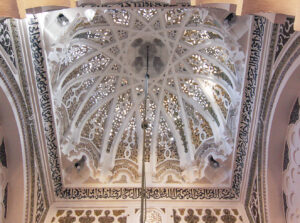
Mihrab dome, Great Mosque of Tlemcen, Algeria, 1136 (Archnet)
Gold-colored vines climb among the 24 slender ribs that weave together across the interior of this dome, forming a 12-pointed star around the center. The spaces between the lace-like vines are pierced, open to the sky, allowing natural light to filter through and illuminate the mosque below. The dome sits above the mihrab, the niche indicating the direction of Mecca, in the Great Mosque of Tlemcen, Algeria. Its intricate decoration and the heavenly glow that it casts make this one of the most remarkable domes of its time.
The art and architecture of the Islamic west, including northwest Africa (known in Arabic as the Maghrib), and al-Andalus (Muslim-ruled regions of the Iberian Peninsula), has often been deemed provincial—overlooked in favor of architectural developments in the central and eastern lands of Islam. The Tlemcen mosque, as well as other related monuments, has been further marginalized, due to its construction under the Almoravid dynasty, one of the so-called “Berber” dynasties who ruled over the Maghrib and al-Andalus in the 11th and 12th centuries. The term Berber, referring to the Indigenous tribal peoples of North Africa, was originally used to indicate someone whose language differed from the languages of Greco-Roman civilization. By the 19th and early 20th century, European colonialist scholarship cast Berber communities and their cultural contributions as backwards and barbarous. However, rather than derivative or provincial, the art and architecture of the region, including the Tlemcen mosque, was rich and vibrant, and it merits attention in its own right.
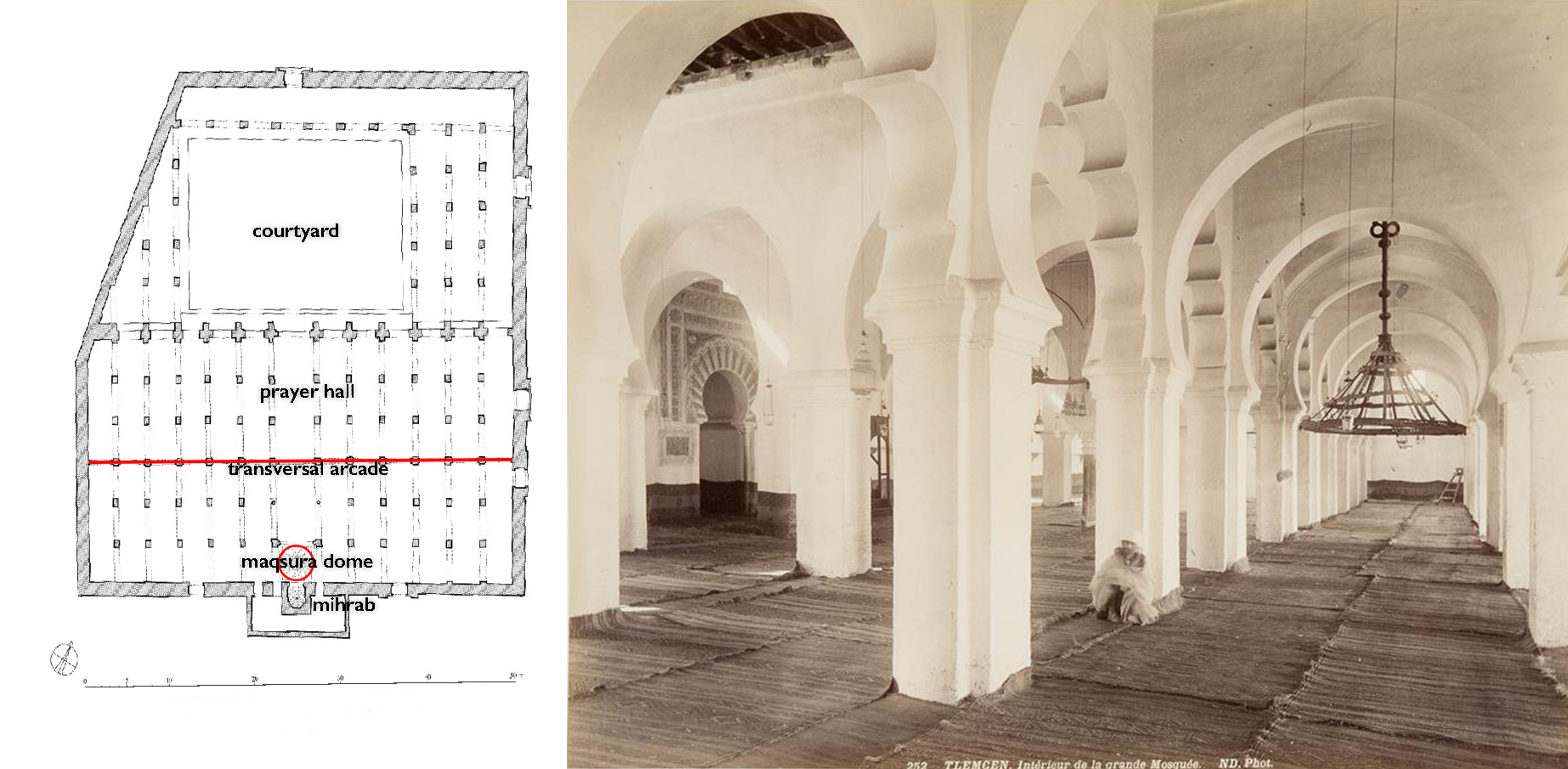
Left: Plan of Tlemcen mosque in 1136 (after Almagro, CC BY-NC 4.0); right: interior, Great Mosque of Tlemcen, showing horseshoe arcades (the view to the right) and a transversal arcade with polylobed arches (visible in the center of the photograph), 1136 (Hallwylska museet, Stockholm)
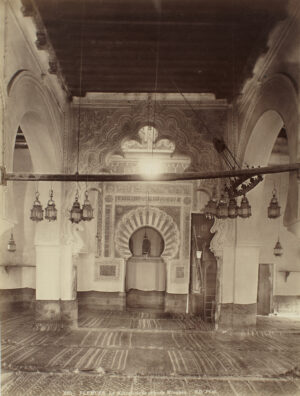
Maqsura and mihrab, Great Mosque of Tlemcen, 1136 (Hallwylska museet, Stockholm)
Tlemcen mosque: architecture and history
In the late 11th century, Almoravid ruler Yusuf ibn Tashufin, dispatched his general to found the city of Tagrart, referred to today as Tlemcen. At the same time, he established the city’s congregational mosque, the Great Mosque of Tlemcen. The prayer hall has 13 aisles formed by arcades of six horseshoe arches running perpendicular to the qibla wall (the wall indicating the direction of Mecca). Various solutions were adopted to emphasize the mihrab and its central importance. For example, most of the arches in the mosque are supported on brick piers (which would become the most common support solution in the region); however, in its initial construction, the two arches closest to the mihrab stood on columns, distinguishing the holy space and creating a more open atmosphere. In addition, the central aisle is wider than the rest, drawing attention to the mihrab. Finally, a transversal arcade (an arcade running parallel to the qibla wall which partitions the prayer hall in two halves), is distinguished by polylobed arches, with the number of lobes increasing around the central aisle to create a visual hierarchy highlighting a view towards the mihrab.
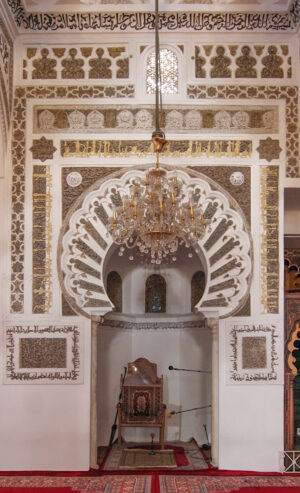
Mihrab, Great Mosque of Tlemcen, 1136 (Archnet)
According to an inscription on the cornice beneath the dome, Yusuf ibn Tashufin’s son ‘Ali b. Yusuf renovated the mosque in 1136. His renovation created a new decorative maqsura (the enclosure situated near the mihrab and usually reserved for the ruler and his entourage). ‘Ali b. Yusuf’s maqsura featured a new polylobed transversal arch (the arch framing the intersection of the central aisle and the qibla), a new decorative façade for the mihrab, and the most innovative element of the mosque’s decoration—its pierced stucco dome.
The mihrab, here opening onto an octagonal recess that projects behind the qibla wall, is richly framed by decorated ornamental moldings framing the outer perimeter of the arch (alfices—singular alfiz). Dedicatory and Quranic inscriptions and carved arabesques and geometric shapes form the borders around the central scallop-shaped alfiz which features alternating voussoirs of plain ground and arabesque ornament. Although today the stucco decoration of the mihrab (and the maqsura as a whole) is overpainted in black, white, and gold, this coloring is not original. It is likely that the mihrab originally resembled the rich red and blue colored stucco mihrab discovered in the Alcázar of Murcia, in what is today southeastern Spain. [1]
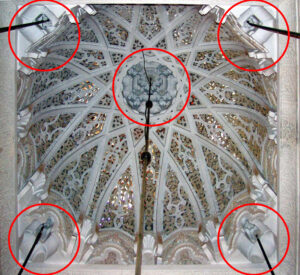
Dome with muqarnas, Great Mosque of Tlemcen, 1136 (Museum with No Frontiers)
In addition to its remarkable pierced plaster panels of vegetal ornament that fill the space between the ribs of the dome, in each of the dome’s four corners and at its center, we find tiers of muqarnas (a complex honey-comb like decoration popular in Islamic architecture). The muqarnas are equally innovative in the Tlemcen dome, as they are one of the earliest examples of the form in the Islamic west.
The profusion of ornament and the dome’s openwork patterns, which radiate natural light throughout the maqsura, would have drawn the worshippers’ attention towards the mihrab as the focus of prayer. At the same time, the decoration, sponsored by ‘Ali b. Yusuf, would have also emphasized his role as patron of the mosque.
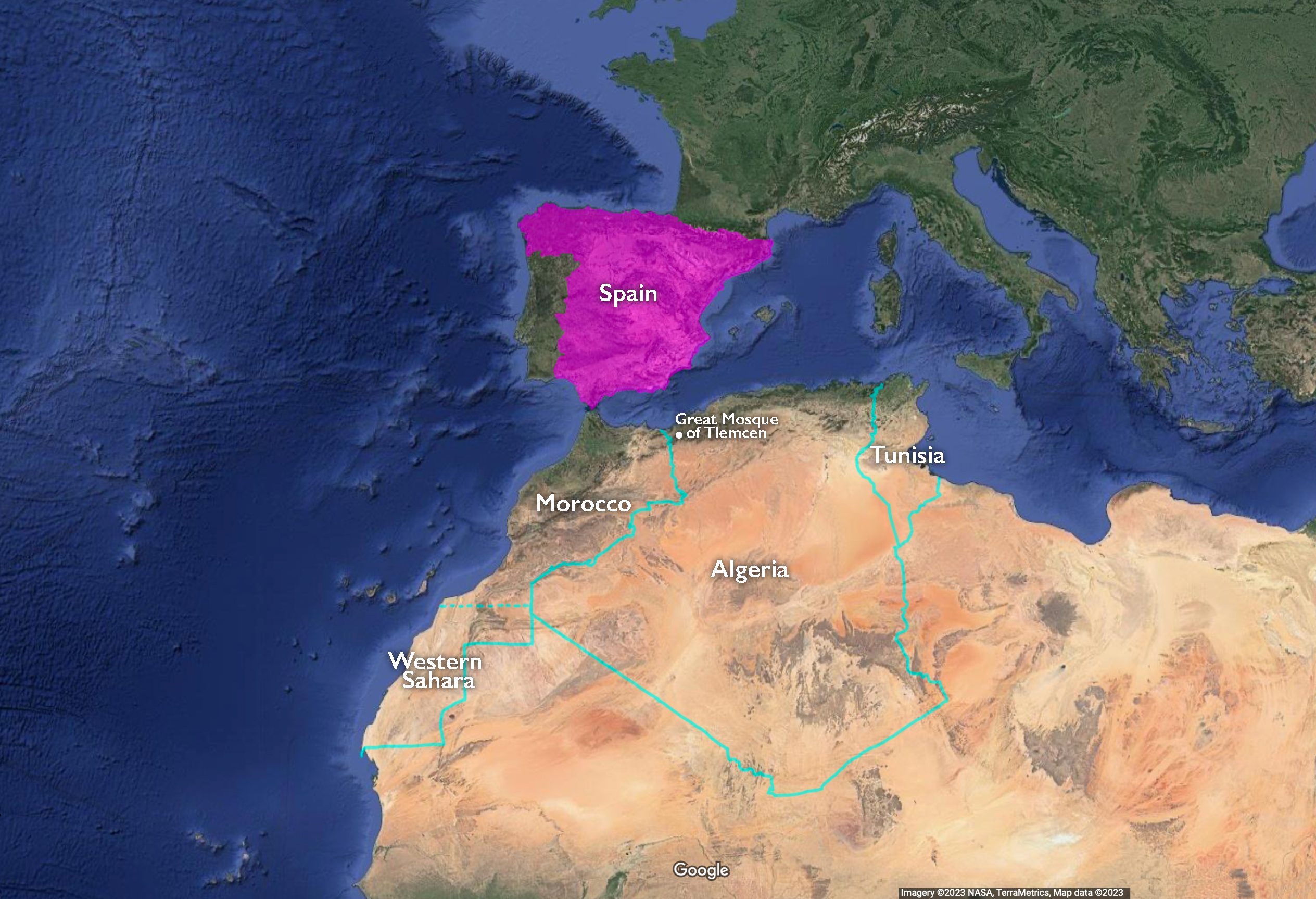
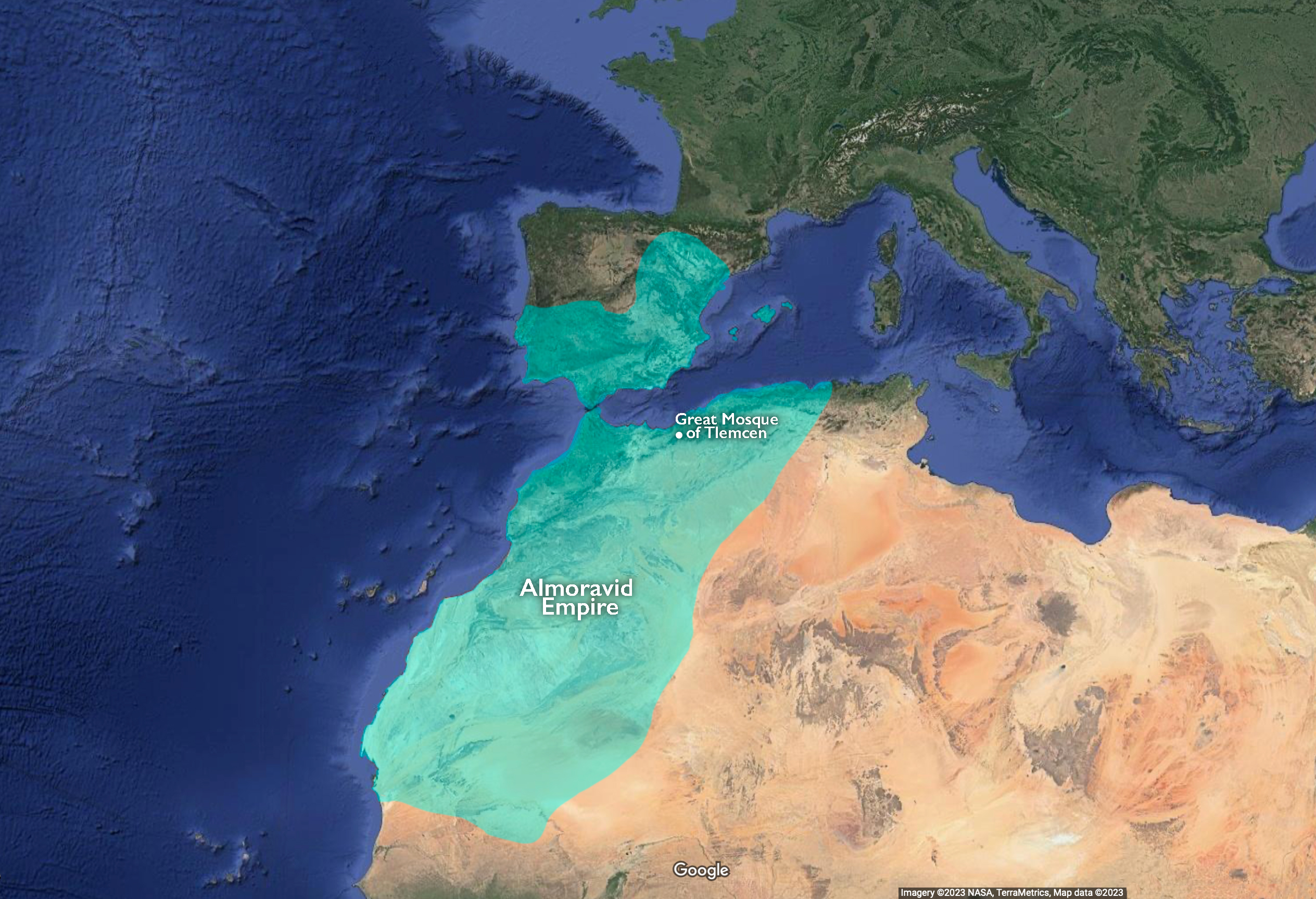
Map of modern Spain and North Africa and the Almoravid Empire at its height in 1117 C.E. (underlying maps © Google)
The Almoravids across the Maghrib and al-Andalus
Today, when we look at a modern map of Spain and North Africa, we envision a clear division between the two regions—a European nation in the north and the African continent in the south. But this modern divide obscures a much more complex history. From the 11th through 13th centuries, two rival Berber dynasties, the Almoravids and later the Almohads, sought to conquer and unify the Maghrib and al-Andalus in the name of their respective interpretations of Islam.
The Almoravids sprang from a confederation of Sanhaja Berber tribes based in what is today Niger and Mali. They gradually conquered much of northwestern Africa. Their control of the trans-Saharan trade routes allowed them not only to enrich their empire with the proceeds of trade in salt, gold, and enslaved peoples, but also to disseminate more widely their particular religious beliefs. [2] Although they were initially content to rule over the Maghrib (North Africa), when the Muslim rulers over the kingdoms of al-Andalus, known as the Taifa kings, asked the Almoravids for help defending against encroaching Christian armies, they crossed the Strait of Gibraltar, defeated the Christians, and remained in al-Andalus, uniting it with their empire in northwestern Africa. For the first time, they had created a new cultural corridor that extended from the Sahara of West Africa to al-Andalus. Al-Andalus, which had previously been a leading center of the Islamic west under Umayyad rule, now shifted to a province on the edge of an empire whose heartlands were in North Africa.
As a new dynasty, having brought diverse groups under their rule, the Almoravids sought ways to secure loyalty from the peoples across their empire and to publicly express their legitimacy. They inserted themselves into existing Islamic paradigms of authority, including recognizing the Abbasid caliphs in Baghdad as the spiritual heads of Islam. [3] At the same time, they invested in major building programs, including the construction of new mosques in Algiers, Tlemcen, and Taza, and the restoration of existing sites, such as the Friday mosque of Granada and the Qarawiyyin mosque in Fez, to affirm their authority.
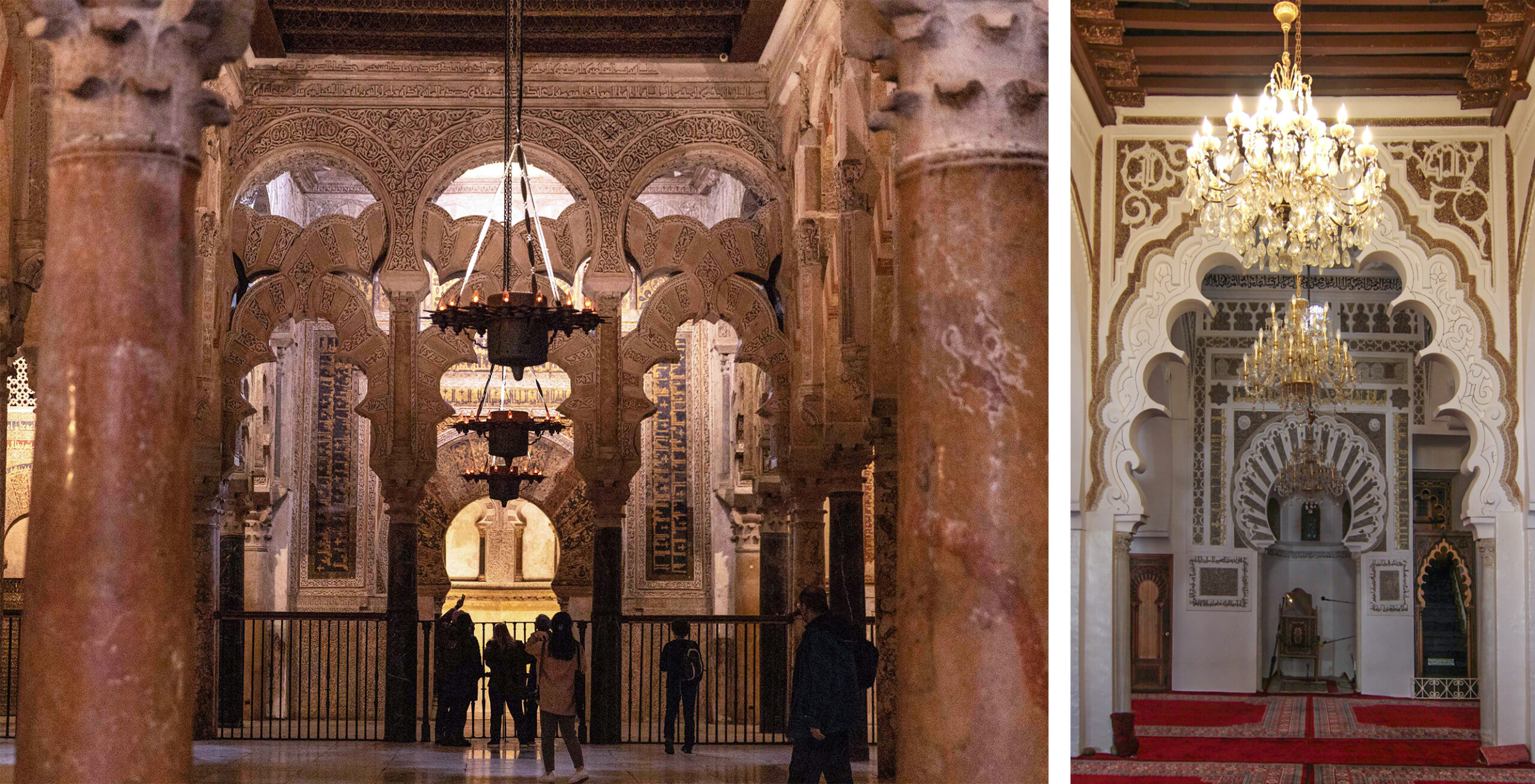
Left: Maqsura and mihrab, Great Mosque of Córdoba, 961–965 (Ariel Fein, CC BY-NC 4.0); right: Maqsura and mihrab, Great Mosque of Tlemcen (Archnet)
The Tlemcen Mosque between the Maghreb and al-Andalus
The decoration of the Tlemcen mosque by ‘Ali b. Yusuf, as well as the construction and adornment of other Almoravid monuments, actively combined local Maghribi and Andalusi art and architecture as an expression of their new empire’s reach across northwestern Africa and southern Iberia. ‘Ali b. Yusuf’s maqsura was likely inspired by the late 10th-century expansion of the Great Mosque of Córdoba by Umayyad caliph al-Hakam II. Al-Hakam II similarly built a new maqsura, framed by highly ornate, multilobed arches featuring elaborate carved foliate motifs. The distinctive decoration of the arches, like that of the transversal arch in Tlemcen, indicate to the worshiper that they are entering a new, sacred space.

Left: Dome, Great Mosque of Tlemcen, 1136 (Museum With No Frontiers); center: Dome, Bar al-Mardum, 999/1000 C.E. (photo: Manuel de Corselas, CC BY-SA 3.0); right: left dome, maqsura, Great Mosque of Córdoba, 961–965 (photo: Manuel de Corselas, CC BY-SA 3.0)
Similarly, the Tlemcen mosque’s dome may have also been loosely based on the model of ribbed domes first seen in al-Hakam’s extension of the Great Mosque of Córdoba, and later in other Andalusi monuments, such as the Mosque of Bab al-Mardum in Toledo. Ribbed domes would become popular in North African Almoravid mosques, incorporated in other monuments constructed under ‘Ali b. Yusuf’s patronage, including the Qubbat al-Barudiyyin in Marrakech. However, while the Tlemcen dome may owe its origins to the Andalusi ribbed domes, the remarkable perforated decoration and its celestial light effects for which it is so revered was an original development likely first seen in the Great Mosque of Tlemcen.
Today, the vegetal tracery of the Tlemcen mihrab dome is unparalleled in the western Islamic world. However, it is unlikely that it was wholly unique in its own time. Its delicate vegetal decoration shares affinities with the arts of the al-Andalus under the Taifa kings. For example, the 11th-century stucco arches of the Aljafería palace bear similarly exuberant vegetal and floral ornamentation, indicating a more widespread decorative approach.
These connections with Andalusi art and architecture indicate not only the increased opportunity for artistic exchange across the Strait of Gibraltar, but also a deliberate appropriation of Andalusi styles. Within only a few short years of achieving their maximum territorial expansion, the Almoravid Empire was once again besieged on all sides—Christian kingdoms advancing in northern al-Andalus, and a new, rival Berber movement, the Almohads, emerging in the Maghrib. The fusion of Córdoban and Taifa elements with local Maghribi forms in the Tlemcen mosque, as well as other monuments, may reflect ‘Ali b. Yusuf’s need to assert the legitimacy and stability of his empire through an artistic language already associated with Andalusi prestige and power.
Notes:
[1] See Julio Navarro Palazón and Pedro Jiménez Castillo, “La arquitectura de Ibn Mardanîsh: Revisión y nuevas aportaciones,” La Aljafería y el Arte del Islam Occidental en el siglo XI, edited by Gonzalo M. Borrás Gualis and Bernabé Cabañero Subiza (Zaragoza: Institución Fernando el Católico, 2012), pp. 291–350.
[2] The Almoravids advocated for the more conservative teachings of the Maliki school of Islamic law. Amira Bennison, “Malikism, Mahdism, and Mysticism: Religion and Learning, 1050–1250,” The Almoravid and Almohad Empires (Edinburgh: Edinburgh University Press, 2016), pp. 227–75.
[3] Although by this time, the Abbasid caliph no longer had real military or political reach, they held symbolic legitimacy based on their direct descent from the Prophet Muhammad’s family. By including the Abbasid caliph’s name on their coinage, for example, the Almoravids lent legitimacy to their own claim to power. Yasser Tabbaa argues that the Almoravids also deliberately adopted elements of Abbasid architecture and decoration to enhance their legitimacy, as part of what has been called the “Sunni Revival.” However, it is more likely that their architectural patronage drew more upon local Maghribi and Andalusi approaches.
Additional resources
A. Almagro, “The Great Mosque of Tlemcen and the Dome of its Maqsura,” al-Qantara, volume 36, number 1 (2015), pp. 199–257.
Abigail Balbale, “Bridging Seas of Sand and Water: The Berber Dynasties of the Islamic Far West,” A Companion to Islamic Art and Architecture, edited by Gulru Necipoglu and Finbar Barry Flood (Hoboken: Wiley-Blackwell, 2017), pp. 356–77.
Amira Bennison, The Almoravid and Almohad Empires (Edinburgh: Edinburgh University Press, 2016).
Jonathan Bloom, “The Almoravids and Almohads, c. 1050–c. 1250,” Architecture of the Islamic West: North Africa and the Iberian Peninsula, 700–1800 (New Haven: Yale University Press, 2020), pp.108–48.
Camilo Gómez-Rivas, “Berber Rule and Abbasid Legitimacy: The Almoravids (434/1042–530/1147),” The Routledge Handbook of Medieval Iberia (London: Routledge, 2020), pp. 89–113.
Cynthia Robinson, “Power, Light, Intra-Confessional Discontent, and the Almoravids,” Envisioning Islamic Architecture: Essays in Honor of Renata Holod (Leiden: Brill Publishers, 2014), pp. 22–45.
Mariam Rosser-Owen, “Andalusi Spolia in Medieval Morocco: ‘Architectural Politics, Political Architecture,’” Medieval Encounters, volume 20, number 2 (2014), pp. 152–98.
Yasser Tabbaa, “Andalusian roots and Abbasid homage in the Qubbat al-Barudiyyin in Marrakech,” Muqarnas, volume 25 (2008), pp. 134–46.

